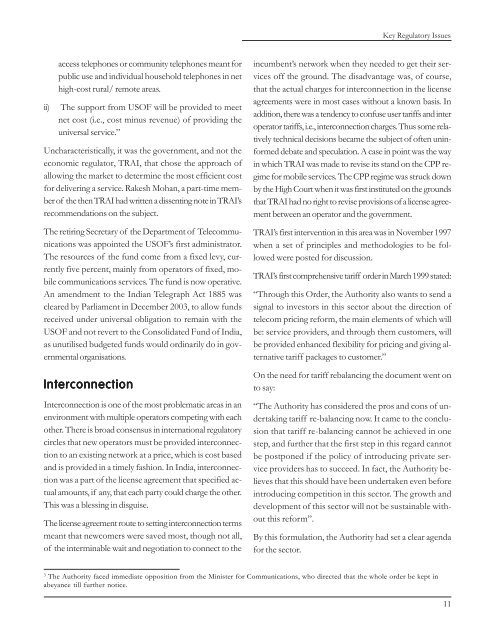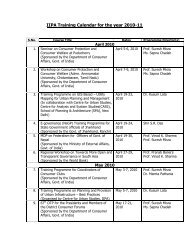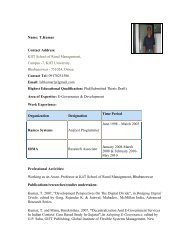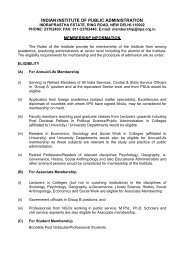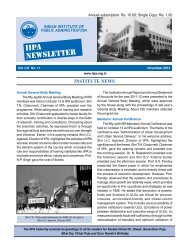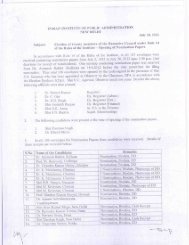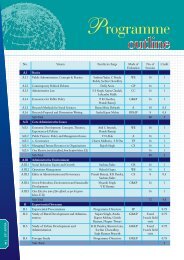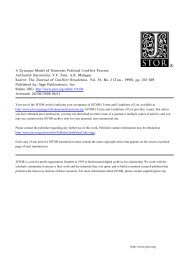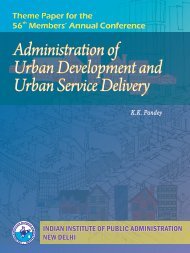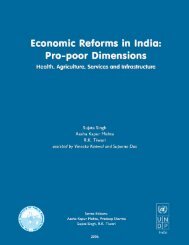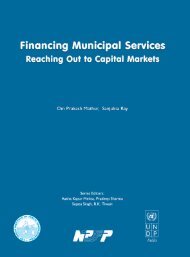India's Telecom Reform - Indian Institute of Public Administration
India's Telecom Reform - Indian Institute of Public Administration
India's Telecom Reform - Indian Institute of Public Administration
Create successful ePaper yourself
Turn your PDF publications into a flip-book with our unique Google optimized e-Paper software.
Key Regulatory Issues<br />
access telephones or community telephones meant for<br />
public use and individual household telephones in net<br />
high-cost rural/ remote areas.<br />
ii) The support from USOF will be provided to meet<br />
net cost (i.e., cost minus revenue) <strong>of</strong> providing the<br />
universal service.”<br />
Uncharacteristically, it was the government, and not the<br />
economic regulator, TRAI, that chose the approach <strong>of</strong><br />
allowing the market to determine the most efficient cost<br />
for delivering a service. Rakesh Mohan, a part-time member<br />
<strong>of</strong> the then TRAI had written a dissenting note in TRAI’s<br />
recommendations on the subject.<br />
The retiring Secretary <strong>of</strong> the Department <strong>of</strong> <strong>Telecom</strong>munications<br />
was appointed the USOF’s first administrator.<br />
The resources <strong>of</strong> the fund come from a fixed levy, currently<br />
five percent, mainly from operators <strong>of</strong> fixed, mobile<br />
communications services. The fund is now operative.<br />
An amendment to the <strong>Indian</strong> Telegraph Act 1885 was<br />
cleared by Parliament in December 2003, to allow funds<br />
received under universal obligation to remain with the<br />
USOF and not revert to the Consolidated Fund <strong>of</strong> India,<br />
as unutilised budgeted funds would ordinarily do in governmental<br />
organisations.<br />
Interconnection<br />
Interconnection is one <strong>of</strong> the most problematic areas in an<br />
environment with multiple operators competing with each<br />
other. There is broad consensus in international regulatory<br />
circles that new operators must be provided interconnection<br />
to an existing network at a price, which is cost based<br />
and is provided in a timely fashion. In India, interconnection<br />
was a part <strong>of</strong> the license agreement that specified actual<br />
amounts, if any, that each party could charge the other.<br />
This was a blessing in disguise.<br />
The license agreement route to setting interconnection terms<br />
meant that newcomers were saved most, though not all,<br />
<strong>of</strong> the interminable wait and negotiation to connect to the<br />
incumbent’s network when they needed to get their services<br />
<strong>of</strong>f the ground. The disadvantage was, <strong>of</strong> course,<br />
that the actual charges for interconnection in the license<br />
agreements were in most cases without a known basis. In<br />
addition, there was a tendency to confuse user tariffs and inter<br />
operator tariffs, i.e., interconnection charges. Thus some relatively<br />
technical decisions became the subject <strong>of</strong> <strong>of</strong>ten uninformed<br />
debate and speculation. A case in point was the way<br />
in which TRAI was made to revise its stand on the CPP regime<br />
for mobile services. The CPP regime was struck down<br />
by the High Court when it was first instituted on the grounds<br />
that TRAI had no right to revise provisions <strong>of</strong> a license agreement<br />
between an operator and the government.<br />
TRAI’s first intervention in this area was in November 1997<br />
when a set <strong>of</strong> principles and methodologies to be followed<br />
were posted for discussion.<br />
TRAI’s first comprehensive tariff order in March 1999 stated:<br />
“Through this Order, the Authority also wants to send a<br />
signal to investors in this sector about the direction <strong>of</strong><br />
telecom pricing reform, the main elements <strong>of</strong> which will<br />
be: service providers, and through them customers, will<br />
be provided enhanced flexibility for pricing and giving alternative<br />
tariff packages to customer.”<br />
On the need for tariff rebalancing the document went on<br />
to say:<br />
“The Authority has considered the pros and cons <strong>of</strong> undertaking<br />
tariff re-balancing now. It came to the conclusion<br />
that tariff re-balancing cannot be achieved in one<br />
step, and further that the first step in this regard cannot<br />
be postponed if the policy <strong>of</strong> introducing private service<br />
providers has to succeed. In fact, the Authority believes<br />
that this should have been undertaken even before<br />
introducing competition in this sector. The growth and<br />
development <strong>of</strong> this sector will not be sustainable without<br />
this reform”.<br />
By this formulation, the Authority had set a clear agenda<br />
for the sector.<br />
3<br />
The Authority faced immediate opposition from the Minister for Communications, who directed that the whole order be kept in<br />
abeyance till further notice.<br />
11


